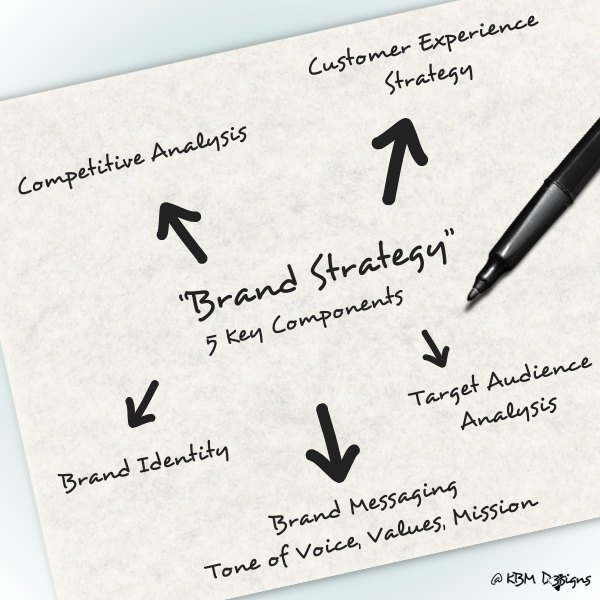So, what is a brand strategy, and how does it apply to small business offline objectives? In an era dominated by digital marketing and online presence, it’s easy for small businesses to overlook the importance of offline brand strategy. While online visibility is critical, especially in the current digital environment. Offline strategies still carry significant weight. Particularly for small businesses targeting local markets.

Article Content:
- Defining Brand Strategy
- Key Components of Brand Strategy
- Offline Objectives for Small Businesses
3.1 Community Engagement
3.2 Brick-and-Mortar Presence
3.3 Networking
3.4 Print Collateral
3.5 Local Media Outreach - FAQ’s about “What is a Brand Strategy?”
1. Defining Brand Strategy
- Definition: Brand strategy encompasses the overarching plan that dictates how a business aims to establish and position its brand in the market. It involves defining the brand’s identity, values, mission, and vision, as well as determining the target audience and crafting messaging that resonates with them.
- Focus: Brand strategy focuses on the long-term vision and goals of the brand. It involves developing a comprehensive framework that guides all branding efforts, including marketing, communication, and customer experience initiatives.
- Purpose: The purpose of brand strategy is to create a strong, cohesive identity for the brand that differentiates it from competitors, builds trust with consumers, and fosters loyalty over time.
2. Key Components of Brand Strategy

- Brand Identity: This encompasses the visual elements that represent the brand, such as logo, colors, typography, and imagery. Consistency across these elements helps in establishing brand recognition and recall.
- Brand Messaging: This includes the tone of voice, brand values, mission statement, and key messaging points. It’s essential for communicating what the brand stands for and building emotional connections with the target audience.
- Target Audience: Understanding the demographics, psychographics, and behaviors of the target audience is crucial for tailoring branding efforts effectively.
- Competitive Analysis: Analyzing competitors helps in identifying gaps in the market, understanding industry trends, and determining how to differentiate the brand.
- Customer Experience: Every interaction a customer has with the brand shapes their perception. Ensuring a seamless and positive experience across all touch-points is vital for building brand loyalty.
3. Offline Objectives for Small Businesses
While online channels offer extensive reach and targeting options, offline strategies remain indispensable for small businesses, especially those operating within a local community. Here are some key offline objectives small businesses should consider in their brand strategy:
- Community Engagement: Actively participating in local events, sponsoring community initiatives, or hosting workshops not only increases brand visibility but also fosters a sense of trust and loyalty within the community.
- Brick-and-Mortar Presence: For businesses with physical locations, creating a welcoming and memorable in-store experience is essential. This includes aspects such as store layout, interior design, signage, and customer service.
- Networking: Building relationships with other local businesses, industry associations, and relevant stakeholders can lead to valuable partnerships, collaborations, and word-of-mouth referrals.
- Print Collateral: Despite the rise of digital marketing, printed materials like business cards, rack cards, flyers, brochures, vehicle magnets, and signage still play a crucial role in offline brand promotion, especially in local marketing and face-to-face interactions.
- Local Media Outreach: Leveraging local newspapers, magazines, radio stations, and community websites can help small businesses reach their target audience effectively, particularly if they’re looking to attract customers within a specific geographical area.
The bottom line is that a robust brand strategy is critical for SMBs that want to be seen and heard. While digital channels offer immense opportunities, offline strategies remain invaluable. This is especially true for local businesses that want to connect with their community on a more personal level. By prioritizing offline goals and aligning them with their overall brand strategy, small businesses can effectively differentiate themselves. In doing so, they help build loyalty and ensure lasting success.
3.1 Community Engagement
Community engagement is a critical aspect of offline brand strategy for small businesses. Here’s a deeper dive into why it’s important and how it can benefit businesses:
Building Relationships:
By actively participating in local events, sponsoring community initiatives, or hosting workshops, small businesses can connect with community members on a personal level. These interactions provide opportunities to build genuine relationships, which are essential for fostering trust and loyalty.
Establishing Brand Presence:
When a business participates in local events or sponsors community activities, it puts its brand front and center in the minds of community members. This increased visibility helps to establish brand recognition and awareness within the local market.
Creating Positive Associations:
By associating their brand with community events or initiatives, businesses can create positive associations in the minds of consumers. When people see a business actively supporting local causes or participating in community activities, it can evoke feelings of goodwill and positivity towards the brand.
Demonstrating Values:
Community engagement provides an opportunity for businesses to demonstrate their values and commitment to the community. By supporting local causes or hosting educational workshops, businesses showcase their dedication to making a positive impact beyond just their products or services.
Word-of-Mouth Marketing:
Actively engaging with the community can lead to positive word-of-mouth marketing. When community members have positive experiences with a business through their participation in local events or workshops, they are more likely to recommend the business to friends, family, and colleagues.
Enhancing Brand Loyalty:
Community engagement efforts help to build strong emotional connections with customers. When people see that a business genuinely cares about the community and its members, they are more likely to feel loyal to that business and choose it over competitors.
Gathering Feedback and Insights:
Engaging with the community provides businesses with valuable opportunities to gather feedback and insights. Whether it’s through direct interactions with customers at events or through conversations during workshops, businesses can gain valuable insights into the needs, preferences, and challenges of their target audience.
Overall, community engagement is a powerful tool for small businesses to not only increase brand visibility but also to build trust, loyalty, and positive brand associations within their local community. By investing time and resources into community engagement efforts, businesses can strengthen their position in the market and drive long-term success.
3.2 Brick-and-Mortar Presence
A brick-and-mortar presence is crucial for businesses with physical locations, as it provides a tangible space for customers to interact with the brand. Here’s a deeper exploration of why creating a welcoming and memorable in-store experience is essential, along with key aspects to consider:
Creating a Welcoming Atmosphere:
The physical environment of a store plays a significant role in shaping the overall customer experience. A welcoming atmosphere can make customers feel comfortable and valued, encouraging them to spend more time browsing and engaging with products.
Memorable In-Store Experience:
An exceptional in-store experience can leave a lasting impression on customers and differentiate a business from its competitors. Memorable experiences often lead to positive word-of-mouth recommendations and repeat visits.
Store Layout:
The layout of a store should be intuitive and easy to navigate. A well-designed layout guides customers through the store, making it effortless for them to find what they’re looking for. It’s essential to consider factors such as aisle width, product placement, and traffic flow when designing the layout.
Interior Design:
The interior design of a store sets the tone and atmosphere for the shopping experience. Elements such as lighting, color scheme, decor, and furniture contribute to the overall ambiance. A cohesive and aesthetically pleasing interior design can enhance the perceived value of products and create a pleasant shopping environment.
Signage:
Clear and informative signage is essential for guiding customers and communicating important information. From directional signs to product displays and pricing signage, effective signage helps customers navigate the store and find relevant information quickly.
Customer Service:
Excellent customer service is a cornerstone of a successful brick-and-mortar presence. Friendly and knowledgeable staff members can assist customers, answer questions, and provide personalized recommendations. Positive interactions with staff can significantly impact customer satisfaction and loyalty.
Brand Consistency:
The in-store experience should align with the brand’s values, personality, and identity. Consistency across all touch-points reinforces brand messaging and strengthens brand recognition. From the decor and signage to the behavior of staff members, every aspect of the in-store experience should reflect the brand’s image.
Creating Engagement Opportunities:
In-store experiences can go beyond transactions to create opportunities for engagement and interaction. Interactive displays, product demonstrations, or workshops can enhance the overall shopping experience and encourage customer engagement.
In conclusion, creating a welcoming and memorable in-store experience is essential for businesses with physical locations. By focusing on aspects such as store layout, interior design, signage, and customer service, businesses can enhance the overall customer experience, differentiate themselves from competitors, and build stronger connections with customers. A well-executed brick-and-mortar presence can drive foot traffic, increase sales, and foster long-term loyalty.
3.3 Networking
Networking is a vital component of any business strategy, especially for small businesses operating within a local community. Here’s a deeper exploration of why networking is important and how it can benefit businesses:
Building Relationships:
Networking provides opportunities to connect with other local businesses, industry associations, and stakeholders on a personal level. Building genuine relationships based on trust and mutual respect forms the foundation for fruitful collaborations and partnerships.
Access to Resources:
By networking with other businesses and industry associations, small businesses can gain access to valuable resources, such as expertise, knowledge, and support services. Whether it’s sharing best practices, receiving mentorship, or accessing specialized training programs, networking opens doors to a wealth of resources that can help businesses grow and thrive.
Collaboration Opportunities:
Networking often leads to collaboration opportunities, where businesses can work together on projects, events, or marketing campaigns. Collaborations allow businesses to pool their resources, reach a broader audience, and achieve mutual goals more effectively. Collaborative efforts can also lead to innovative solutions and new business opportunities that may not have been possible individually.
Partnerships and Referrals:
Building relationships through networking can lead to valuable partnerships and referrals. When businesses trust and respect each other, they are more likely to refer customers, clients, or leads to one another. Word-of-mouth referrals from trusted sources carry significant weight and can result in new business opportunities and increased revenue.
Industry Insights and Trends:
Networking provides opportunities to stay informed about industry trends, market developments, and best practices. By engaging with peers and industry associations, businesses can gain valuable insights into emerging trends, consumer preferences, and competitive strategies. Staying abreast of industry developments helps businesses adapt and stay competitive in a rapidly changing marketplace.
Enhancing Visibility and Credibility:
Active participation in networking events, industry associations, and community initiatives can enhance a business’s visibility and credibility within the local community. When businesses are seen as active contributors and participants in the community, they gain trust and respect from customers, peers, and stakeholders, which can lead to increased brand recognition and loyalty.
Personal and Professional Growth:
Networking provides opportunities for personal and professional growth, both for business owners and their employees. Engaging with other professionals, attending industry events, and participating in networking groups can broaden perspectives, develop new skills, and foster continuous learning and development.
In summary, networking is a powerful strategy for small businesses to build relationships, access resources, collaborate with others, and stay competitive in their local market. By actively engaging with other businesses, industry associations, and stakeholders, small businesses can unlock a wealth of opportunities for growth, innovation, and success.
3.4 Print Collateral
Print collateral remains an integral part of offline brand promotion for several reasons, despite the prevalence of digital marketing channels. Let’s delve deeper into why print materials are still crucial, particularly in face-to-face interactions:
Tangibility and Memorability:
Print materials provide a tangible form of communication that engages multiple senses. Unlike digital content, which can be easily overlooked or forgotten, physical materials such as business cards, flyers, and brochures allow for a tactile experience that leaves a lasting impression on the recipient. The act of holding a well-designed brochure or business card can create a memorable interaction that reinforces brand recall.
Personalization and Customization:
Print collateral offers opportunities for personalization and customization to cater to specific audiences or occasions. Businesses can tailor the design, messaging, and content of print materials to align with the preferences and needs of their target audience. Personalized print collateral demonstrates attentiveness and professionalism, enhancing the perceived value of the brand.
Versatility and Accessibility:
Print materials can be distributed and accessed in various settings, making them highly versatile for offline brand promotion. Whether it’s handing out thank you business cards at networking events, distributing flyers in high-traffic areas, or displaying signage at a physical location, print collateral allows businesses to reach their target audience in different contexts and touch-points.
Complementing Digital Marketing Efforts:
While digital marketing channels offer extensive reach and targeting capabilities, print materials complement these efforts by providing a tangible extension of the brand experience. Integrating print collateral with digital campaigns creates a cohesive and multi-channel marketing strategy that maximizes brand visibility and engagement across both online and offline channels.
Establishing Brand Trust and Credibility:
Well-designed and professionally printed materials reflect positively on the brand’s image and credibility. High-quality print collateral communicates attention to detail, reliability, and investment in the brand’s presentation, instilling confidence and trust in potential customers. In face-to-face interactions, the physical presence of printed materials can enhance the perceived legitimacy and professionalism of the business.
Targeting Local Audiences:
For small businesses targeting local markets, print materials are particularly effective for reaching geographically specific audiences. Localized print campaigns can effectively target residents, businesses, and community members within a specific area, driving foot traffic, generating leads, and fostering community engagement.
Nurturing Relationships:
Print collateral serves as a tangible reminder of the brand long after the initial interaction. Whether it’s a brochure left behind at a meeting or a flyer posted on a community bulletin board, print materials keep the brand top-of-mind and provide opportunities for follow-up and further engagement with potential customers.
To summarize, printed collateral continues to play a vital role in offline brand promotion, especially in face-to-face interactions. Its tangibility, personalization, versatility, and ability to complement digital marketing efforts make it an essential component of a comprehensive marketing strategy. It is for businesses seeking to maximize their reach, engagement, and brand visibility both online and offline.
3.5 Local Media Outreach
Local media outreach is a powerful strategy for small businesses aiming to connect with their target audience within a specific geographical area. Here’s a deeper exploration of why leveraging local newspapers, magazines, radio stations, and community websites is essential and how it can benefit small businesses:
Targeting Local Audiences:
Local media outlets cater to audiences within a specific geographic region, making them highly effective channels for reaching local consumers. By leveraging local newspapers, magazines, radio stations, and community websites, small businesses can directly target the demographics and interests of their local community, ensuring that their marketing messages resonate with the intended audience.
Building Community Engagement:
Local media outlets are deeply embedded within the communities they serve, making them valuable platforms for building community engagement. Small businesses can use these channels to share their stories, showcase their involvement in local events or initiatives, and highlight their contributions to the community. By aligning their brand with local interests and concerns, businesses can foster stronger connections with local consumers and build trust and loyalty over time.
Amplifying Brand Visibility:
Being featured in local newspapers, magazines, radio programs, or community websites can significantly amplify a small business’s brand visibility within its target market. Whether through feature articles, interviews, or advertisements, exposure in local media outlets increases brand awareness and enhances the business’s visibility among local consumers. This heightened visibility can translate into increased foot traffic, website visits, and customer inquiries for the business.
Establishing Authority and Credibility:
Being featured in reputable local media outlets can help small businesses establish authority and credibility within their local community. When a business is mentioned or endorsed by trusted local media sources, it lends credibility to the brand and reinforces its reputation as a reputable and trustworthy entity. This can be particularly impactful for small businesses looking to gain the trust of local consumers and differentiate themselves from competitors.
Driving Local Traffic and Sales:
Local media outreach can directly contribute to driving foot traffic and sales for small businesses. Promotions, events, or special offers advertised through local newspapers, radio stations, or community websites can incentivize local consumers to visit the business’s physical location or website, resulting in increased sales and revenue. Additionally, mentions or reviews in local media outlets can prompt word-of-mouth recommendations and referrals from local consumers, further driving traffic and sales for the business.
Supporting Community Journalism:
By engaging with local media outlets, small businesses also play a role in supporting community journalism and contributing to the vibrancy of local media ecosystems. Investing in advertising or sponsorship opportunities with local newspapers, magazines, radio stations, and community websites helps sustain these vital sources of information and entertainment, ensuring that they continue to serve the needs of the local community.
In summary, local media outreach is a valuable strategy for small businesses. Especially for those who want to effectively reach and engage with target audiences within a specific geographic area. By leveraging local newspapers, magazines, radio stations and community websites, businesses can increase brand visibility. They also build community engagement, establish authority and credibility, drive local traffic and sales, and support community journalism. All of which contribute to their overall growth and success within their local market.
-

How To Choose A Life Coach Business Card Template
Read the post …: How To Choose A Life Coach Business Card Template -

What Is A Gift Voucher? An SMB Offline Marketing Perspective
Read the post …: What Is A Gift Voucher? An SMB Offline Marketing Perspective -

What is a Planner? A Small Business Perspective
Read the post …: What is a Planner? A Small Business Perspective
4. FAQ’s about “What is a Brand Strategy?”
A brand strategy is a comprehensive plan that outlines how a company aims to position itself in the market, connect with its target audience, and differentiate itself from competitors.
A brand strategy is important because it guides all aspects of branding, including messaging, visual identity, customer experience, and marketing efforts. It helps businesses establish a strong brand presence, build customer loyalty, and drive long-term success.
The key components of a brand strategy include brand identity (logo, colors, typography), brand messaging (tone of voice, values, mission), target audience analysis, competitive analysis, and customer experience strategy.
While a brand strategy focuses on defining the brand identity, positioning, and values, a marketing strategy outlines specific tactics and channels for promoting the brand and driving sales. Brand strategy sets the foundation for marketing efforts.
A brand strategy can help a small business differentiate itself in a competitive market, build brand recognition, establish credibility, connect with its target audience, and foster customer loyalty, ultimately driving growth and success.
Brand strategy should be reviewed regularly to ensure it remains aligned with the evolving needs of the business and its target audience. Depending on factors such as market trends and business goals, a brand strategy may be updated annually or as needed.
-

What Is A Brand Partnership? – A Small Business Perspective
Read the post …: What Is A Brand Partnership? – A Small Business Perspective -

What Are Business Objectives?” Perspective Of A Small Business
Read the post …: What Are Business Objectives?” Perspective Of A Small Business -

What Is A Focus Group Market Research? – SMB Perspective
Read the post …: What Is A Focus Group Market Research? – SMB Perspective


